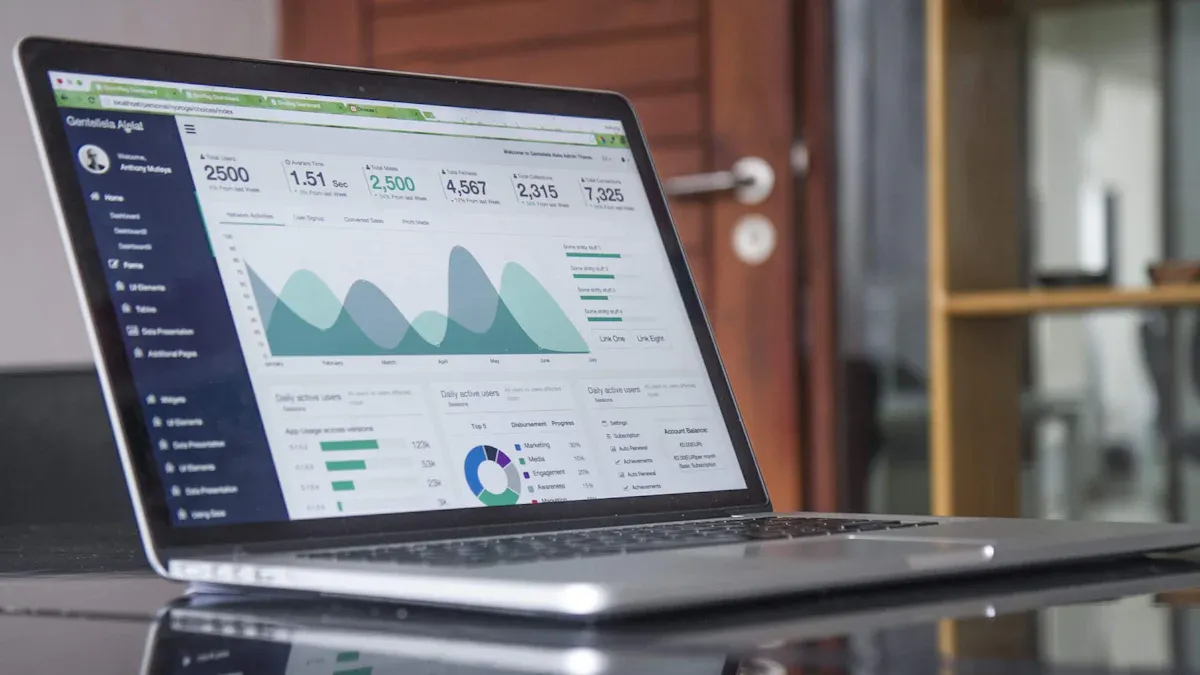AI Strategies for Maximizing Ad Engagement

AI strategies are transforming how businesses connect with their audience. Companies implementing AI strategies experience a 76% increase in profits and 257% more clicks. The AI ad market is projected to grow to $107.5 billion by 2028. Adopting AI strategies has become essential for staying competitive.
Key Takeaways
AI methods can greatly improve how people interact with ads. Businesses using AI get 257% more clicks and 76% more money.
AI makes ads personal by matching them to people's likes. This builds better customer relationships and boosts sales.
Clear and measurable goals are key for using AI well. Try the SMART method to decide what success means for your ads.
Understanding AI in Advertising
What is AI in Advertising?
AI in advertising means using smart systems to improve marketing. These systems act like humans by learning from data and finding patterns. Over time, they get better at their tasks. Demis Hassabis, who started DeepMind, says AI is "making machines smart." AI helps machines do things like read text, spot objects, and study how people behave. Advertisers use AI to make campaigns that work better and have a bigger impact.
How AI Improves Engagement
AI changes how businesses reach their audience. It customizes ads for different groups, making them more meaningful. For example, AI studies what people like and adjusts ads to fit their tastes. This makes ads connect better with viewers, increasing interest. AI also looks at huge amounts of data to guess trends. This helps businesses show ads to the right people at the right time. Companies using AI see 257% more clicks, says the Journal of Marketing Analytics.
Why Use AI in Advertising?
AI-based advertising has many perks. It uses past data to help you make smart choices. This lets you spend money wisely and improve your ads. For example, Stitch Fix uses AI to make super-personalized ads, gaining 45% more new customers. Sephora’s AI visual search increased customer interest by 87%. These examples show how AI can make ads perform better and bring real results.
AI Strategies for Maximizing Ad Engagement

Personalized Advertising for Targeted Messaging
AI helps create ads that match people's likes and needs. It studies what users do, buy, and search for online. This helps make ads that feel personal to each person. For example, Stitch Fix uses AI to check over 30 details about each customer. This helped them get 45% more first-time buyers and cut costs by 21%. Sephora also uses AI to let people search with pictures. This made customers 87% more interested and boosted sales by 31%.
Industry | AI Strategy | Technology | Results |
|---|---|---|---|
Fashion Retail | Custom Campaigns | Machine Learning & Data Analysis | Better customer interest and more sales with tailored offers. |
Healthcare | Better Patient Targeting | Predictive Analytics & Pattern Recognition | Lower costs and better outreach for health services. |
Travel & Tourism | Flexible Pricing & Deals | AI Algorithms for Dynamic Pricing | More bookings during slow times and better travel deals. |
Education | Content Interest Tracking | Natural Language Processing (NLP) | More interaction with learning materials and better content matching. |
Environmental Services | Smarter Awareness Campaigns | AI-Driven Segmentation & Targeting | Bigger reach and better results for eco-friendly campaigns. |
These examples show how AI makes ads more useful and powerful.
Audience Segmentation for Precise Targeting
AI splits audiences into groups by studying lots of data. This helps match ads to what each group likes and cares about. Ads that fit people’s interests work better and lead to more sales. For example, marketers use segmentation to find their best audience. They learn what these groups need and spend money wisely. This builds stronger customer connections and increases sales.
Benefit | Description |
|---|---|
Better Relevance | Ads match what each group likes, so they notice them more. |
More Personalization | Ads fit specific needs, making people more likely to buy. |
Stronger Customer Bonds | Builds trust and loyalty with messages that feel personal. |
Using AI for segmentation helps your ads reach the right people at the right time.
Predictive Analytics for Smarter Campaigns
Predictive analytics uses AI to guess trends and customer actions. This helps businesses make smarter ad choices. Companies using AI see a 76% higher return on investment than old methods. AI also cuts customer-getting costs by 30%. These tools help you spend money wisely and make ads that work better.
Dynamic Content Optimization for Real-Time Customization
Dynamic content optimization uses AI to change ads as people interact with them. This keeps ads interesting and useful. For example, BMW saw more clicks and sales with personalized ads. AI-powered ads often lead to better engagement and more sales. This makes it a key part of today’s advertising.
Real-Time Ad Targeting for Enhanced ROI
Real-time ad targeting uses AI to quickly adjust ads for better results. AI tools check how ads are doing and move money to the best ones. They also stop spending on ads that don’t work well. Companies using AI see a 76% higher return on investment and 40% more sales. This makes sure every dollar spent on ads counts.
Implementing AI Strategies Effectively
Setting Clear Campaign Goals
To use AI strategies well, start with clear goals. Follow the SMART method:
Specific: Decide what success means, like "Get 20% more ad clicks in 3 months."
Measurable: Pick goals you can track with numbers.
Achievable: Choose realistic targets your team can reach.
Relevant: Make sure goals match your business plans.
Time-bound: Set deadlines to stay focused and on track.
Check how your business is doing now and involve your team in planning. For example, if you want more customer interest, focus on click rates or time spent on your site.
Selecting the Right AI Tools and Platforms
Picking the right tools is very important. Find platforms that work well with your current systems. Look for tools with features like audience grouping, trend guessing, and real-time ad changes. Work with AI experts to make tools fit your needs. Good data is key, so keep it clean and updated for better results.
Testing and Refining AI-Driven Approaches
Start small to test your AI strategies. Try pilot projects to see what works best. Companies that improve their AI methods report 76% better ROI and 30% lower costs to get customers.
Metric | Improvement Percentage |
|---|---|
ROI Increase | 76% |
Customer Acquisition Cost Reduction | 30% |
Higher Conversion Rates | 40% |
Click-Through Rate Growth | 257% |
Testing step-by-step helps you adjust based on real results.
Monitoring and Analyzing Performance Metrics
Watching how your ads perform is very important. Focus on numbers like ROI, clicks, and conversions. Predictive metrics, like future revenue or customer trends, help you make smart choices.
Check these numbers often to find ways to improve and make your ads work better.
Overcoming Challenges in AI Advertising
Keeping Data Safe and Private
AI ads often use personal data, which can cause worries. Many systems collect user data without asking clearly. This leaves people unsure about how their data is used. When companies hide this, trust can be lost. Big data leaks and secret data use show the dangers of poor handling.
To fix this, protect user data with strong rules. Make clear policies so users know how their data is used. Use privacy-friendly AI tools and follow rules like GDPR. Being open builds trust and keeps ads safer.
Fixing Bias in AI Systems
AI bias is a big problem in advertising. If AI uses bad or unfair data, it gives wrong results. For example, healthcare AI has been less accurate for some groups. Hiring AI has unfairly picked more men due to biased data. These mistakes can hurt your brand and upset customers.
To avoid bias, use many data sources and check AI often. Work with experts to find and fix unfairness. Fair AI helps you make ads that connect with everyone.
Being Clear and Responsible
Clear and responsible AI use is very important. Rules like GDPR and OECD AI Principles push for fair and open AI. These rules help find bias and improve AI work.
Rule/Standard | What It Does |
|---|---|
General Data Protection Regulation | Protects user data and explains how it’s collected and used. |
OECD AI Principles | Promotes safe, fair, and ethical AI practices. |
U.S. GAO AI Accountability Framework | Sets rules for who is responsible for AI decisions. |
Following these rules builds trust with users. Explaining how your AI works shows fairness and honesty.
Mixing AI with Human Input
AI is great at handling data, but humans are still needed. AI can’t think creatively or make ethical choices. Companies with high success mix AI’s data skills with human ideas. This makes campaigns better.
Set up ways to check and improve AI systems. Make sure they match your brand’s values. Humans help with tough decisions and new tech. By combining AI and human effort, you can make ads that work well and feel right.
The Future of AI Strategies in Ad Engagement

Emerging Trends in AI-Powered Advertising
AI-powered ads are changing fast, bringing new ideas to life. One big trend is privacy-preserving AI, which studies data safely without risking privacy. This builds trust and follows rules. Another cool idea is emotion AI, which guesses how people feel about ads. This helps brands make ads that connect better with viewers.
Another growing tool is prescriptive analytics. It suggests actions and makes tough choices easier. For example, it helps marketers pick the best places for ads or change budgets quickly. Voice-activated ads are also becoming popular. As more people use voice search, AI makes sure ads work well in this area, keeping businesses ahead.
AI’s Role in Shaping Consumer Behavior
AI changes how people act by giving them personal experiences. It finds top customers, learns what they like, and adjusts ads for them. For example, companies using AI personalization see 10-30% more money (Boston Consulting Group, 2023). AI also boosts interest by finding the best content styles, leading to 47% more interaction (Content Marketing Institute, 2023).
AI improves ad results by making them work better. Companies using AI get 76% more ROI and spend 30% less to get customers (McKinsey, 2022). Almost half of people (49%) like ads with AI-made personal content. This shows how much AI affects what people buy.

Long-Term Potential of AI in Marketing
AI has a bright future in marketing. The global AI market is expected to grow to $20.4 billion by 2024. From 2025 to 2030, it will grow 25% each year. This shows how much businesses rely on AI for better targeting and personal ads.
AI is also shifting focus from products to customers. By learning what people want, businesses can make ads that matter more. AI also predicts the best ways to spend money on ads, saving resources. As AI gets smarter, it will play an even bigger role in marketing plans.
AI changes ads by making them more personal and effective. It helps target the right people and improves campaigns. To use AI well:
Set clear goals that are easy to measure.
Pick tools that match your needs.
Check how your ads are doing often.
Use AI to keep your ads strong and stay ahead of others.
FAQ
What is the biggest advantage of using AI in advertising?
AI helps make ads that feel personal to viewers. This makes people more interested and increases sales by showing the right content to the right audience.
How can small businesses benefit from AI-driven advertising?
AI tools handle tasks like finding the right audience and improving ads. This saves both time and money, helping small businesses compete better.
Tip: Try free or cheap AI tools first to see how they help your ads.
Is AI difficult to implement in advertising campaigns?
No, many AI tools are simple to use. You can connect them to your current tools and improve ads without needing special skills.
Note: Pick tools with guides or support to make learning easier.
See Also
Harnessing TikTok Data Tools to Boost Audience Engagement
Enhancing Blog Traffic Through Effective Email List Engagement
Proven Techniques for Growing Your Blogging Audience Effectively

